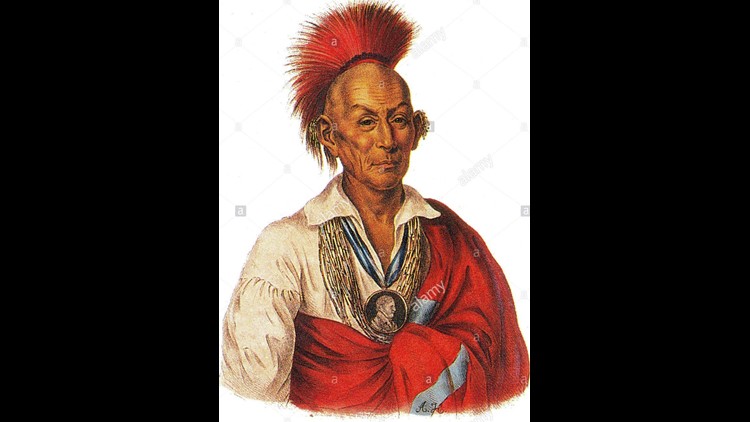ROCK ISLAND, Illinois — In the early 1800s the Sauk and Fox Indians lived along the Mississippi River from northwestern Illinois to southwestern Wisconsin. The Sauk leader Black Sparrow Hawk was born in Saukenuk, a large village at the mouth of the Rock River located near present-day Rock Island, Illinois.
In 1830, seeking to make way for settlers moving into Illinois, the United States required the Sauk to move and accept new lands in present-day Iowa.
As the U.S. Army built more forts and droves of settlers moved into the territory, Black Hawk grew increasingly angry. Finally, in 1831, settlers began to occupy present-day Rock Island.
In Iowa, the Sauk struggled to prepare enough acreage for their crops. The winter of 1831-1832 was extremely difficult.
In April 1832, despite a treaty signed in 1804, Black Hawk led about 1,000 Sauk and Fox people back to northern Illinois. Black Hawk hoped to forge a military alliance with the Winnebago and other tribes. They intended to plant corn on their ancestral farmland.
Yet an undisciplined militia ignored a peace flag and attacked the Sauk. The Indian warriors promptly returned fire.
The militia retreated in a panic, many forgetting their firearms. The Sauk collected the weapons and retreated northward along the Rock River into Wisconsin. The Black Hawk War had begun.
General Henry Atkinson was in charge of U.S. Army forces, assisted by four thousand militiamen led by Henry Dodge and James Henry.
Traveling with small children and elderly members of the tribe, the Sauk and Fox were unable to move as rapidly as the soldiers.
On July 21, 1832, soldiers led by Henry Dodge caught up with Black Hawk’s band near the Wisconsin River, outside of present-day Sauk City. Although greatly outnumbered, Sauk warriors turned the attack on American troops, allowing the Indian women and children to flee across the Wisconsin River.
The next morning, the American troops discovered that the Sauk warriors had vanished, having quietly forded the river in darkness. Dodge subsequently fell back, journeying north to Fort Winnebago (near present-day Portage) to obtain supplies.
At Fort Winnebago, Dodge joined forces with Atkinson and set out in pursuit of the Sauk and Fox. Most members of the starving band had fled west, hoping to find sanctuary among tribes beyond the Mississippi River.
On August 2, U.S. soldiers attacked the Sauk and Fox as they attempted to ford the Mississippi River, near what is now Victory in Vernon County.
Ignoring a truce flag, the troops aboard a river steamboat fired cannons and rifles, killing hundreds, including many children. Many of those who made it across the river were slain by the Eastern Sioux, allies of the Americans in 1832.
Only 150 of the one thousand members of Black Hawk’s band survived the events of the summer of 1832. Survivors rejoined the Sauk and Fox who had remained in Iowa.
Black Hawk surrendered to officials at Fort Crawford, Prairie du Chien. The defeated warrior was imprisoned and sent east to meet with President Andrew Jackson and other government officials. Eventually the U. S. government sent him to live with surviving members of the Sauk and Fox nation.
Read more about the Black Hawk War at history.com.



